|
|
 |
Fiche d'espèce de Copépode |
|
|
Calanoida ( Ordre ) |
|
|
|
Diaptomoidea ( Superfamille ) |
|
|
|
Candaciidae ( Famille ) |
|
|
|
Candacia ( Genre ) |
|
|
| |
Candacia discaudata A. Scott, 1909 (F,M) | |
| | | | | | | Syn.: | Candacia bradyi : Carl, 1907 (p.9, part., figs.F) | | | | Ref.: | | | A. Scott, 1909 (p.157, figs.F,M); Sewell, 1914 a (p.230, Rem.); 1932 (p.335); Mori, 1937 (1964) (p.81, figs.F,M); Krishnaswamy, 1953 (p.129, fig.F); Chiba, 1956 (p.38, figs. Juv.M); Chiba & al., 1957 (p.310); 1957 a (p.11); Brodsky, 1962 c (p.140, figs.F); Grice, 1963 (p.175, Rem.); Kasturirangan, 1963 (p.44, 47, figs.F,M); Chen & Zhang, 1965 (p.92, figs.F,M); Kos, 1972 (Vol. I, figs F, M, Descr.); Lawson, 1973 a (p.487, Rem.); Marques, 1976 (p.994, fig.F); Lawson, 1977 (p.71, tab.2,3,4, fig.5); Greenwood, 1978 (p.9, figs.F); Marques, 1982 (p.763); Chihara & Murano, 1997 (p.753, Pl.73,76: F,M); Mulyadi, 1997 a (p.87, Redescr.F,M, figs.F,M); Vaupel Klein & Gassmann, 1998 (p.443, fig.M); Bradford-Grieve, 1999 b (p.168, figs.F,M, figs.182, 193); Conway & al., 2003 (p.1108, figs.F,M, Rem.); Mulyadi, 2004 (p.86, figs.F,M, Rem.); | 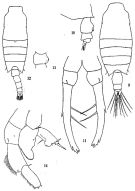 issued from: Q.-c Chen & S.-z. Zhang in Studia Marina Sinica, 1965, 7. [Pl.37, 9-14]. Female (from E China Sea): 9, habitus (dorsal); 10, urosome (lateral right side); 11, P5 (posterior). Male: 12, habitus (dorsal); 13, genital segment (dorsal); 14, P5 (posterior).
|
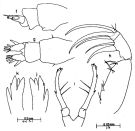 issued from : J.G. Greenwood in Proc. R. Soc. Qd, 1978, 89. [p.10, Fig.4]. Female (from Moreton Bay, E Australia): f, urosome (lateral right side); g, idem (dorsal); h, Mx2; i, P5; j-k, detail terminal portions of P5.
|
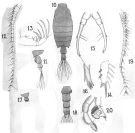 issued from : A. Scott in Siboga-Expedition, 1909, XIX a. [Plate XLVII, Figs.10-20]. Female (from Indonesia-Malaysia): 10, habitus (dorsal); 11, last thoracic and urosome (left side); 12, A1; 13, Mx2; 14, P3 (terminal spine on last segment of exopodite); 15, P5; 16, apex of last segment of P5 (enlarged). Male: 17, last thoracic and genital segments; 18, urosome (dorsal); 19, right A1; 20, P5.
|
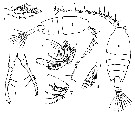 issued from : T. Mori in The Pelagic copepoda from the neighbouring waters of Japan, 1937 (1964). [Pl. 54, Figs.1-7]. Female: 1, P3; 3, P5; 5, P1; 6, habitus (dorsal). Male: 2, habitus (dorsal); 4, P5; 7, Mx2.
|
 issued from : N. Phukham in Species diversity of calanoid copepods in Thai waters, Andaman Sea (Master of Science, Univ. Bangkok). 2008. [p.145, Fig.19]. Female (from W Malay Peninsula): a, habitus (dorsal), A1 (at left side); b, urosome (dorsal); c, P5. Male: d, habitus (dorsal); e, urosome (dorsal); f, same (lateral, right side); g, P5. Body length after the drawings: F: = 1.943 mm; M = 1.543 mm.
|
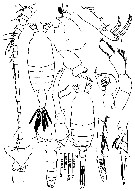 issued from : Mulyadi in Published by Res. Center Biol., Indonesia Inst. Sci. Bogor, 2004. [p.87, Fig.48]. Female (from 03°40'S, 128°10'E)): A, habitus (dorsal); B, forehead (lateral); C, angle of the 5th metasomal somite and urosome (lateral left side); D, A1; E, Mx2; F, P1; G, P5. Nota: The female is identifiable by ventral protrusion on urosomite2 and multiple apical teeth of the P5. Male: H, habitus (dorsal); I, angles of the 5th metasomal somite and urosome (dorsal); J, 5th metasomal somite and genital somite and urosomal somites 1 and 2 (lateral right side); K, 16th to 19th segments of right A1; L, P5 (anterior view). Nota: The male is identifiable by the single lateral swelling on genital somite and the form of the P5.
|
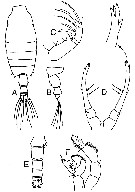 Issued from : J.M. Bradford-Grieve in NIWA Biodiversity Memoir 111, 1999. [p.168, Fig.118]. After Scott, 1909. Female (from SW Pacific): A, habitus (dorsal); B, urosome (lateral); C, Mx2; D, P5. Male (from SW Pacific): E, urosome (dorsal); F, P5. Female characteristics: - Posterior metasome points symmetrical, directed ventrally. Genital segment slightly asymmetrical viewed dorsally, without lateral projections, but with a short seta on each side; without any knob-like protrusions on the ventral side. Urosomal segment 2 considerably expanded in lateral view. - Anal segment distinctly asymmetrical. A1 23-segmented, extends to the middle of the genital segment. Mx2 basipod 2 with 2 spines, the proximal spine slightly longer and thicker than the distal spine P5 asymmetrical, apex of segment 3 produced into 3 closely set teeth, outer margin with 2 small spines, 2 moderately long setae on inner margin. Male characteristics: - Genital segment is asymmetrical, viewed dorsally the distal end right side is much inflated, viewed from right the inflated region bears a small tooth at each end. - Anal segment asymmetrical as in female. - Right A1 23-segmented, segments 2 and 3 fused, hinge between segments 18 and 19, segments 17 and 18 separate, segments 19 and 20 fused, outer margin of segments 16-18 are provided with rows of pigmented teeth as in C. bradyi. - Mx2 basipod 2 proximal spine considerably thicker than distal spine. - P5 left segments moderately long and broad, segment 4 with 2 small outer edge spines and 2 small apical spines; segment 3 of right leg has a large projection near distal end of inner margin.
|
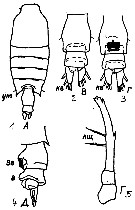 Issued from : M.C. Kos in Field guide for plankton. Zool Institute USSR Acad., Vol. I, 1972. After Brodsky, 1962. Female: 1, habitus (doesal); 2-3, abdomen (dorsal and ventral, respectively); 4, abdomen (lateral); 5, P5.
| | | | | Ref. compl.: | | | Sewell, 1912 (p.353, 367); 1948 (p.418, 426); Ganapati & Shanthakumari, 1962 (p.9, 15); Stephen & Iyer, 1979 (p.228, tab.1, 3, 4, figs.3, 4); Sreekmaran Nair & al., 1981 (p.493, Fig.2); Dessier, 1983 (p.89, Tableau 1, Rem., %); Guangshan & Honglin, 1984 (p.118, tab.); Madhupratap & Haridas, 1986 (p.105, tab.1); Cervantes-Duarte & Hernandez-Trujillo, 1989 (tab.3); Othman & al., 1990 (p.561, 564, Table 1); Shih & Young, 1995 (p.69); Kotani & al., 1996 (tab.2); Noda & al., 1998 (p.55, Table 3, occurrence); Suarez-Morales & Gasca, 1998 a (p108); Lo & al., 2001 (1139, tab.I); Hsiao & al., 2004 (p.325, tab.1); Razai & al., 2004 (p.490, tab.2); Osore & al., 2004 (p.195); Lan & al., 2004 (p.332, tab.1); Lo & al., 2004 (p.89, tab.1); Zuo & al., 2006 (p.159, tab.1, abundance, fig.8: stations group); Dur & al., 2007 (p.197, Table IV); Fernandes, 2008 (p.465, Tabl. 2); Lan Y.C. & al., 2008 (p.61, Table 1, % vs stations); C.-Y. Lee & al., 2009 (p.151, Tab.2); W.-B. Chang & al., 2010 (p.735, Table 2, abundance); Shanthi & Ramanibai, 2011 (p.132, Table 1); Pillai H.U.K. & al., 2011 (p.239, Table 3, vertical distribution); Hsiao S.H. & al., 2011 (p.475, Appendix I); Maiphae & Sa-ardrit, 2011 (p.641, Table 2); Palomares-Garcia & al., 2013 (p.1009, Table I, abundance vs. environmental factors): in CalCOFI regional list (MDO, Nov. 2013; M. Ohman, pers. comm.); Tseng & al., 2013 (p.507, seasonal abundance); Jagadeesan & al., 2013 (p.27, Table 3, 5, 6, fig.11, seasonal abundance); | | | | NZ: | 7 | | |
|
Carte de distribution de Candacia discaudata par zones géographiques
|
| | | | | | | | | 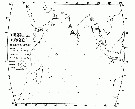 issued from : T.J. Lawson in Marine Biology, 1977, 43. [Fig.5, p.81]. issued from : T.J. Lawson in Marine Biology, 1977, 43. [Fig.5, p.81].
Distribution map for the Indian Ocean. |
 issued from : Mulyadi in Treubia, 1997, 31 (2). [p.109, Fig.16]. issued from : Mulyadi in Treubia, 1997, 31 (2). [p.109, Fig.16].
Distribution of Candaciidae in Indonesian waters. 5: C. discaudata.
|
| | | | Loc: | | | Kennya, Rodrigues Is., Seychelles, India (off Cochin, Lawson's Bay, Madras, G. of Mannar), E India, Bay of Bengal, Andaman Sea (Batten Island), Straits of Malacca, Thailand, Indonesia-Malaysia, Java (Cilacap Bay, ,off Sirabaya) Lombok Sea, Flores Sea, China Seas (East China Sea, South China Sea), Taiwan (S, SW, E, NW, NE), Japan, Kuchinoerabu Is., Pacif. (E- W equatorial), Australia (G. of Carpentaria, Great Barrier, Moreton Bay), W Pacif., Bikini Is., W Baja California, G. of California (rare) | | | | N: | 49 (Indian: 18; Indo-Malaysia: 6; Pacif.: 25) | | | | Lg.: | | | (5) F: 1,94; M: 1,8; (34) F: 1,82-1,6; M: 1,82-1,52; (150) F: 1,7; (290) F: 1,68; M: 1,6; (334) F: 1,94; M: 1,8; (778) F: 1,7-1,6; M: 1,6-1,54; (795) F: 1,9; (991) F: 1,55-1,94; M: 1,48-1,8; (1122) F: 1,65; M: 1,6; (1260) F: 1,7-1,8; M: 1,7; {F: 1,55-1,94; M: 1,48-1,82}
The mean female size is 1.752 mm (n = 12; SD = 0.1479), the mean male size is 1.656 mm (n = 10; SD = 0.1339). The size ratio (male : female) is 0.95 (n = 7; SD = 0.0192). | | | | Rem.: | Cette espèce est caractéristique des formes indo-pacifique ouest.
Voir aussi les remarques en anglais | | | Dernière mise à jour : 09/12/2020 | |
|
|
 Toute utilisation de ce site pour une publication sera mentionnée avec la référence suivante : Toute utilisation de ce site pour une publication sera mentionnée avec la référence suivante :
Razouls C., Desreumaux N., Kouwenberg J. et de Bovée F., 2005-2025. - Biodiversité des Copépodes planctoniques marins (morphologie, répartition géographique et données biologiques). Sorbonne Université, CNRS. Disponible sur http://copepodes.obs-banyuls.fr [Accédé le 17 novembre 2025] © copyright 2005-2025 Sorbonne Université, CNRS
|
|
 |
 |













